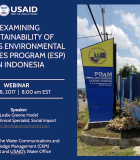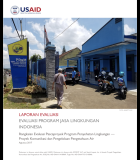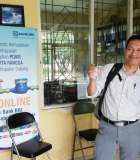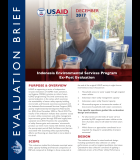Environmental Services Program (ESP)
The Environmental Services Program (ESP) was a sixty-four month program funded by the United States Agency for International Development (USAID) and implemented under the leadership of Development Alternatives, Inc. (DAI). ESP works with government, the private sector, NGOs, community groups, and other stakeholders to improve the management of water resources and expand access to safe water by strengthening watershed management and delivery of key environmental services, including clean water supply, wastewater collection and treatment, and solid waste management.
ESP provides technical assistance and related services to impact USAID’s Strategic Objective No. 2, Higher Quality Basic Human Services Utilized (BHS). BHS focuses on the interdependence of health and the environment and their impact on health outcomes. To achieve this, USAID strives to increase access and utilization of key health and environmental services, particularly to users currently underserved or not served at all. Central to the program includes a coordinated, collaborative, and integrated approach involving all of the programs of the Basic Human Services Office of USAID.
In order to more effectively impact the success rate of BHS programs, strong efforts are made to ensure as much synergy within the program as possible. The ESP project is committed to working closely with and in parallel to other relevant USAID programs such as, but not limited to, the Health Services Program (HSP); the Community-Based Influenza Control (CBAIC) project; the Safe Water Systems (SWS) or Aman Tirta program; and the Orangutan Conservation Support Program (OCSP) as well as partners from other donorfunded projects including, but not limited to, the World Bank and Asia Development Bank (ADB).
Activity Description
ESP takes a ‘Ridge to Reef’ approach to water resource management and clean water and sanitation services delivery. Upper watershed activities include forest conservation, critical land rehabilitation and water resource protection. Downstream activities prioritize increasing access to clean water and sanitation services in urban and peri-urban areas. Links are developed between upstream and downstream communities through Payment for Environmental Services (PES), where downstream water resource users pay or reward upstream water resource providers for safeguarding a sustainable supply of clean water. Additionally, both upstream and downstream stakeholders participate in health and hygiene activities aimed at improving health by breaking the fecal-oral transmission cycle. ESP manages its ‘Ridge to Reef’ approach through the following four specific technical components and a number of cross-cutting themes:
- Watershed Management and Biodiversity Conservation works on forest conservation, critical land rehabilitation and water resource protection. This is done through the facilitation of multi-stakeholder watershed management forums, and the development and implementation of watershed management plans.
- Environmental Services Delivery supports increased access to clean water and sanitation services in urban and peri-urban areas. This includes working closely with municipal water companies (PDAMs) to improve and expand services, as well as government agencies, NGOs and community groups to expand sanitation services.
- Environmental Services Finance strives to stimulate investment necessary to increase access to clean water and sanitation services, including development of alternative financing mechanisms for infrastructure development as well as micro-credit for household connections and facilitation of Payment for Environmental Services models.
- Strategic Communications works to communicate ESP results and achievements, public outreach communications to work with journalist networks to communicate ESP principles and approaches, and Health and Hygiene communications to address health issues at the community to household levels.
- Cross-cutting themes supporting these technical components include GIS (Geographic Information Systems), an extensive Small Grants program, Gender awareness and integration, and Monitoring and Evaluation.
Expected Outcomes
- Strengthen the capacity of communities, governments, the private sector, local institutions, and NGOs to advocate for expanded delivery of key environmental services through improved water resources and protected areas management; Expand opportunities for communities, NGOs, private sector and universities to participate more effectively in local management of water resources and delivery of key environmental services;
- Strengthen biodiversity conservation through improving understanding and appreciation for the linkage between protected and forested areas and the delivery of key environmental services; and
- Improve health and livelihoods of Indonesians through improved and expanded access to key environmental services (water, sanitation, solid waste) through the use of appropriate technologies, innovative financing, environmentally sustainable best practices, and sustainable market oriented activities.
Actual Outcomes
- 57 local policies related to land tenure and community access right developed
- 52,561.02 hectares of degraded land rehabilitated
- 214,468 hectares of high conservation value forest under improved local management
- 44 watershed management and 13 water resources management plans developed, funded, and nder implementation by ESP partners
- 477 new community groups practicing improved NRM formed
- 24,665 beneficiaries of ESP’s coastal rehabilitation in Aceh
- 36,507 people trained in natural resources and biodiversity conservation and 7,885 people trained through ESP Field Schools
- 295,965 households (or 1,887,410 people) have increased access to clean water
- 83 community-based solid waste management systems developed with a total of 37,835 beneficiaries
- 69 Small-Scale Sanitation Systems developed with a total of 27,105 beneficiaries 96,131 people trained in effective Hand Washing with Soap
- 25 PDAMs demonstrated an improved operating ratio
- 9 PDAMs supported to develop plans to access commercial financing
- Kabupaten Bogor bond issuance completed
- 22 Master Agreements signed by PDAMs and local banks, and 12,111 new households with access to clean water. ESP leveraged $1,211,100 for these new connections
- $29,969,634.11 of resources leveraged to expand impact of ESP work
- 1,826 households from conflict communities in or adjacent to forest area of high conservation value in Ulu Masen, Aceh have improved livelihoods opportunities
- 1,000 hectares of Hutan Seulawah Agam (protected area) in Krueng Aceh watershed has imroved conservation management
- One final provincial Spatial Plan was produced and submitted to the provincial government to promote people-based development and sustainable NRM in Papua
- One final provincial regulation codifying an investment code for biofuels and palm oil in Papua province was completed
- 80 collaborative programs implemented with USAID partners
- 241 awareness campaigns implemented by ESP and ESP partners





